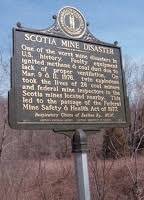44 years later: Scotia Mine disaster remembered
Published 3:09 pm Tuesday, March 10, 2020

File photo
A historical marker was placed near the Scotia Mine disaster site in 2010 in memory of the 26 who lost their lives as a result of two gas explosions. The mine was sealed after the tragedy and stricter mining regulations were later formed.
|
Getting your Trinity Audio player ready...
|
Locals in Harlan and Letcher counties looked back in remembrance on Monday of a double disaster that claimed the lives of 26 men and shook the foundation of an underground mine operated by Scotia Mining in Partridge, a subsidiary of Blue Diamond Coal Company.
On March 9, 1976, the Harlan Enterprise reported on an apparent methane gas explosion which was said to have killed nine miners upon the blast around 11:30 a.m., while another six suffocated and rigged a brattice – a heavy material used during such an explosion to form a safe air pocket — as they awaited rescue.
“We all knew it was going to happen because that mine was rated one of the most gaseous in the country,” said Michael Hogg, a miner and friend of six of the miners, in an interview where he noted hearing fizzing noises caused by gas escaping.
Trending
The federal Mining Enforcement and Safety Administration had previously cited Scotia for methane levels of 5 to 15 percent in the mine. A level of more than 5 percent is considered dangerous.
Roughly 108 men were reportedly working in the Scotia Mine on a spur of Black Mountain when the blast occurred. The mine was classified as gaseous because it was a deep slope shaft which extended approximately 1,200 feet before leveling out and extending another two and a half miles underground.
With eight rescue teams from across the state on the scene, efforts to save the men lasted into the early morning hours of March 10, focusing mostly on rebuilding damaged passage partitions and ventilating the gas from inside the mines shaft.
The bodies of the miners, who had been working on laying rail track in a section branching from the main passage when the explosion occurred in the passageway itself, were found around midnight. The site was located five and a half miles underground.
More details were released a day after the incident and it was determined an inoperative air ventilation system was the cause for such tragedy. The night before the explosion, MESA crews who inspected Scotia Mine had cited the company for not having the proper ventilation and air levels in the area the explosion later happened.
Two days after the first, a second deadly methane gas explosion took the lives of 11 other men, including three federal mine inspectors. The group was conducting repairs on the ventilation system to allow for a safer inspection of the scene when they were trapped and killed by the second disaster. A handful of the men survived the entrapment for a short period of time, sending six clicks on the telephone line twice before they passed.
Trending
Two other inspectors in the mine managed to escape.
Fearing further loss of life, the mine was sealed, entombing the 11 victims of the second blast. Their bodies were recovered later the same year.
The tragedies that occurred at Scotia Mine eventually led to the passage of the Federal Mine Safety and Health Act of 1977, calling for stricter safety requirements and more training for miners. The law not only strengthened a previous act passed in 1969, but also moved the Mine Safety and Health Administration from the Department of the Interior to the Department of Labor.





